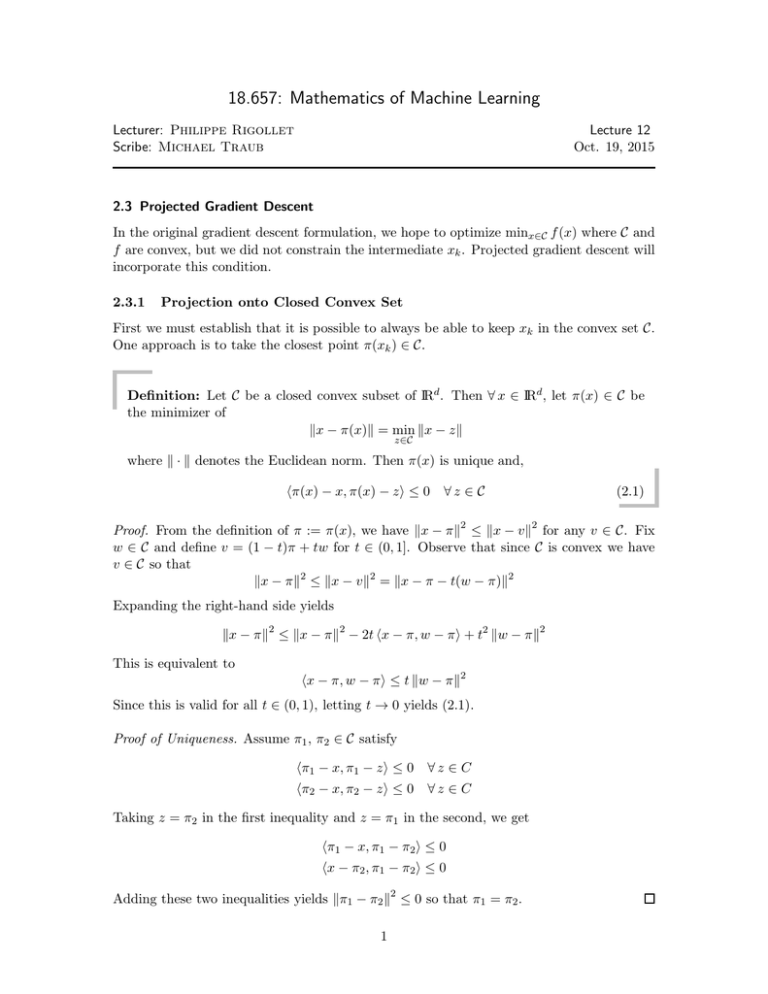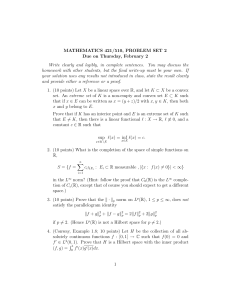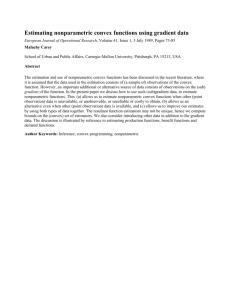18.657: Mathematics of Machine Learning
advertisement

18.657: Mathematics of Machine Learning
Lecturer: Philippe Rigollet
Scribe: Michael Traub
Lecture 12
Oct. 19, 2015
2.3 Projected Gradient Descent
In the original gradient descent formulation, we hope to optimize minx∈C f (x) where C and
f are convex, but we did not constrain the intermediate xk . Projected gradient descent will
incorporate this condition.
2.3.1
Projection onto Closed Convex Set
First we must establish that it is possible to always be able to keep xk in the convex set C.
One approach is to take the closest point π(xk ) ∈ C.
Definition: Let C be a closed convex subset of IRd . Then ∀ x ∈ IRd , let π(x) ∈ C be
the minimizer of
kx − π(x)k = min kx − z k
z∈C
where k · k denotes the Euclidean norm. Then π(x) is unique and,
hπ(x) − x, π(x) − zi ≤ 0
∀z ∈ C
(2.1)
Proof. From the definition of π := π(x), we have kx − πk2 ≤ kx − vk2 for any v ∈ C. Fix
w ∈ C and define v = (1 − t)π + tw for t ∈ (0, 1]. Observe that since C is convex we have
v ∈ C so that
kx − π k2 ≤ kx − v k2 = kx − π − t(w − π)k2
Expanding the right-hand side yields
kx − πk2 ≤ kx − πk2 − 2t hx − π, w − πi + t2 kw − πk2
This is equivalent to
hx − π, w − π i ≤ t kw − πk2
Since this is valid for all t ∈ (0, 1), letting t → 0 yields (2.1).
Proof of Uniqueness. Assume π1 , π2 ∈ C satisfy
hπ1 − x, π1 − zi ≤ 0
hπ2 − x, π2 − zi ≤ 0
∀z ∈ C
∀z ∈ C
Taking z = π2 in the first inequality and z = π1 in the second, we get
hπ1 − x, π1 − π2 i ≤ 0
hx − π2 , π1 − π2 i ≤ 0
Adding these two inequalities yields kπ1 − π2 k2 ≤ 0 so that π1 = π2 .
1
2.3.2
Projected Gradient Descent
Algorithm 1 Projected Gradient Descent algorithm
Input: x1 ∈ C, positive sequence {ηs }s≥1
for s = 1 to k − 1 do
ys+1 = xs − ηs gs , gs ∈ ∂f (xs )
xs+1 = π(ys+1 )
end for
k
1X
return Either x̄ =
xs or x◦ ∈ argmin f (x)
k
x∈{x1 ,...,xk }
s=1
Theorem: Let C be a closed, nonempty convex subset of IRd such that diam(C) ≤ R.
Let f be a convex L-Lipschitz function on C such that x∗ ∈ argminx∈C f (x) exists.
√ then
Then if ηs ≡ η = LR
k
LR
f (x̄) − f (x∗ ) ≤ √
k
Moreover, if ηs =
R
√ ,
L s
and
LR
f (x̄◦ ) − f (x∗ ) ≤ √
k
then ∃c > 0 such that
LR
f (x̄) − f (x∗ ) ≤ c √
k
and
LR
f (x̄◦ ) − f (x∗ ) ≤ c √
k
Proof. Again we will use the identity that 2a⊤ b = kak2 + kbk2 − ka − bk2 .
By convexity, we have
f (xs ) − f (x∗ ) ≤ gs⊤ (xs − x∗ )
1
= (xs − ys+1 )⊤ (xs − x∗ )
η
i
1 h
=
kxs − ys+1 k2 + kxs − x∗ k2 − kys+1 − x∗ k2
2η
Next,
kys+1 − x∗ k2 = kys+1 − xs+1 k2 + kxs+1 − x∗ k2 + 2 hys+1 − xs+1 , xs+1 − x∗ i
= kys+1 − xs+1 k2 + kxs+1 − x∗ k2 + 2 hys+1 − π(ys+1 ), π(ys+1 ) − x∗ i
≥ kxs+1 − x∗ k2
where we used that hx − π(x), π(x) − zi ≥ 0 ∀ z ∈ C, and x∗ ∈ C. Also notice that
kxs − ys+1 k2 = η 2 kgs k2 ≤ η 2 L2 since f is L-Lipschitz with respect to k·k. Using this
we find
k
k
i
1X
1X 1 h 2 2
f (xs ) − f (x∗ ) ≤
η L + kxs − x∗ k2 − kxs+1 − x∗ k2
k s=1
k s=1 2η
≤
ηL2
1
ηL2
R2
+
kx1 − x∗ k2 ≤
+
2
2η k
2
2ηk
2
Minimizing over η we get
L2
2
=
R2
2η2 k
=⇒ η =
R
√ ,
L k
completing the proof
RL
f (x̄) − f (x∗ ) ≤ √
k
2
Pk
∗
∗
Moreover, the proof of the bound for f ( s= k xs ) − f (x ) is identical because x k − x ≤
2.3.3
2
2
R2 as well.
Examples
Support Vector Machines
The SVM minimization as we have shown before is
n
minn
α∈IR
α⊤ IKα≤C 2
1X
max (0, 1 − Yi fα (Xi ))
n
i=1
P
where fα (Xi ) = α⊤ IKei = nj =1 αj K(Xj , Xi ). For convenience, call gi (α) = max (0, 1 − Yi fα (Xi )).
In this case executing the projection onto the ellipsoid {α : α⊤ IKα ≤ C 2 } is not too hard,
but we do not know about C, R, or L. We must determine these we can know that our
bound is not exponential with respect to n. First we find L and start with the gradient of
gi (α):
∇gi (α) = 1I(1 − Yi fα (Xi ) ≥ 0)Yi IKei
ˆ n,ϕ (fα ) = 1 Pn gi (α).
With this we bound the gradient of the ϕ-risk R
i=1
n
X
n
n
1
1X
∂ R̂n,ϕ (fα ) = ∇g
(α)
≤
kIKei k2
i
n
∂α
n
i=1
i=1
by the triangle inequality and the fact that that 1I(1 − Yi fα (Xi ) ≥ 0)Yi ≤ 1. We can now
use the properties of our kernel K. Notice that kIKei k is the ℓ2 norm of the ith column so
1
P
n
2 2 . We also know that
K(X
,
X
)
kIKei k2 =
j
i
j=1
2
K(Xj , Xi )2 = hK(Xj , ·), K(Xi , ·)i ≤ kK(Xj , ·)kH kK (Xi , ·)kH ≤ kmax
Combining all of these we get
1
2
n
n
X
1X
∂
√
2
R̂n,ϕ (fα ) ≤
kmax = kmax n = L
∂α
n
i=1
j=1
To find R we try to evaluate diam{α⊤ IKα ≤ C 2 } = 2
max
α⊤ IKα≤C 2
√
α⊤ α. We can use the
condition to put bounds on the diameter
C 2 ≥ α⊤ IKα ≥ λmin (IK)α⊤ α =⇒ diam{α⊤ IKα ≤ C 2 } ≤ p
2C
λmin (IK)
We need to understand how small λmin can get. While it is true that these exist random
samples selected by an adversary that make λmin = 0, we will consider a random sample of
3
i.i.d
X1 , . . . , Xn ∼ N (0, Id ). This we can write these d-dimensional samples as a d × n matrix
X. We can rewrite the matrix IK with entries IKij = K(Xi , Xj ) = hXi , Xj iIRd as a Wishart
matrix IK = X⊤ X (in particular, 1d X⊤ X is Wishart). Using results from random matrix
√ 2
theory, if we take n, d → ∞ but hold nd as a constant γ, then λmin ( IK
d ) → (1 − γ) . Taking
an approximation since we cannot take n, d to infinity, we get
r n
d
λmin (IK) ≃ d 1 − 2
≥
d
2
using the fact that d ≫ n. This means that λmin becoming too small is not a problem when
we model our samples as coming from multivariate Gaussians.
Now we turn our focus to the number of iterations k. Looking at our bound on the
excess risk
r
n
ˆ
R̂n,ϕ (fα◦R ) ≤ min Rn,ϕ (fα ) + C
kmax
kλmin (IK)
α⊤ IKα≤C 2
we notice that our all of the constants in our stochastic term can be computed given the
number of points and the kernel. Since statistical error is often √1n , to be generous we want
to have precision up to
1
n
to allow for fast rates in special cases. This gives us
k≥
2 C2
n3 kmax
λmin (IK)
which is not bad since n is often not very big.
In [Bub15], the rates for many a wide rage of problems with various assumptions are
available. For example, if we assume strong convexity and Lipschitz we can get an exponential rate so k ∼ log n. If gradient is Lipschitz, then we get get k1 instead of √1k in the bound.
However, often times we are not optimizing over functions with these nice properties.
Boosting
We already know that ϕ is L-Lipschitz for boosting because we required it before.
Remember that our optimization problem is
n
min
α∈IRN
|α|1 ≤1
1X
ϕ(−Yi fα (Xi ))
n
i=1
P
th weak classifier. Remember before we had some rate
where fα = N
j=1 αj fj and fj is the j
q
like c lognN and we would hope to get some other rate that grows with log N since N can
be very large. Taking the gradient of the ϕ-loss in this case we find
N
∇R̂n,ϕ (fα ) =
1X ′
ϕ (−Yi fα (Xi ))(−Yi )F (Xi )
n
i=1
where F (x) is the column vector [f1 (x), . . . , fN (x)]⊤ . Since |Yi | ≤ 1 and ϕ′ ≤ L, we can
bound the ℓ2 norm of the gradient as
n
L
X
F (Xi )
∇R̂n,ϕ (fα ) ≤ 2
n
i=1
≤
n
LX
n
i=1
4
√
kF (Xi )k ≤ L N
using triangle inequality and the fact that F (Xi ) is a N -dimensional vector with each
component bounded in absolute value by 1.
Using the fact th√
at the diameter of the ℓ1 ball is 2, R = 2 and the Lipschitz associated
√L
with our ϕ-risk is L N where L is the Lipschitz constant for ϕ. Our stochastic term R
k
q
1
N
2
becomes 2L k . Imposing the same n error as before we find that k ∼ N n, which is very
bad especially since we want log N .
2.4 Mirror Descent
Boosting is an example of when we want to do gradient descent on a non-Euclidean space,
in particular a ℓ1 space. While the dual of the ℓ2 -norm is itself, the dual of the ℓ1 norm is
the ℓ∞ or sup norm. We want this appear if we have an ℓ1 constraint. The reason for this
is not intuitive because we are taking about measures on the same space IRd , but when we
consider optimizations on other spaces we want a procedure that does is not indifferent to
the measure we use. Mirror descent accomplishes this.
2.4.1
Bregman Projections
Definition: If k·k is some norm on IRd , then k·k∗ is its dual norm.
Example: If dual norm of the ℓp norm k·kp is the ℓq norm k·kq , then 1p + 1q = 1. This is the
limiting case of Hölder’s inequality.
In general we can also refine our bounds on inner products in IRd to x⊤ y ≤ kxk kyk∗ if
we consider x to be the primal and y to be the dual. Thinking like this, gradients live in
the dual space, e.g. in gs⊤ (x − x∗ ), x − x∗ is in the primal space, so gs is in the dual. The
transpose of the vectors suggest that these vectors come from spaces with different measure,
even though all the vectors are in IRd .
Definition: Convex function Φ on a convex set D is said to be
(i) L-Lipschitz with respect to k·k if kgk∗ ≤ L ∀ g ∈ ∂Φ(x) ∀ x ∈ D
(ii) α-strongly convex with respect to k·k if
Φ(y) ≥ Φ(x) + g ⊤ (y − x) +
α
ky − xk2
2
for all x, y ∈ D and for g ∈ ∂f (x)
Example: If Φ is twice differentiable with Hessian H and k·k is the ℓ2 norm, then all
eig(H) ≥ α.
Definition (Bregman divergence): For a given convex function Φ on a convex set
D with x, y ∈ D, the Bregman divergence of y from x is defined as
DΦ (y, x) = Φ(y) − Φ(x) − ∇Φ(x)⊤ (y − x)
5
This divergence is the error of the function Φ(y) from the linear approximation at x.
Also note that this quantity is not symmetric with respect to x and y. If Φ is convex then
DΦ (y, x) ≥ 0 because the Hessian is positive semi-definite. If Φ is α-strongly convex then
DΦ (y, x) ≥ α2 ky − xk2 and if the quadratic approximation is good then this approximately
holds in equality and this divergence behaves like Euclidean norm.
Proposition: Given convex function Φ on D with x, y, z ∈ D
(∇Φ(x) − ∇Φ(y))⊤ (x − z) = DΦ (x, y) + DΦ (z, x) − DΦ (z, y)
Proof. Looking at the right hand side
= Φ(x) − Φ(y) − ∇Φ(y)⊤ (x − y) + Φ(z) − Φ(x) − ∇Φ(x)⊤ (z − x)
h
i
− Φ(z) − Φ(y) − ∇Φ(y)⊤ (z − y)
= ∇Φ(y)⊤ (y − x + z − y) − ∇Φ(x)⊤ (z − x)
= (∇Φ(x) − ∇Φ(y))⊤ (x − z)
Definition (Bregman projection): Given x ∈ IRd , Φ a convex differentiable function
on D ⊂ IRd and convex C ⊂ D̄ , the Bregman projection of x with respect to Φ is
π Φ (x) ∈ argmin Dφ (x, z)
z∈C
References
[Bub15] Sébastien Bubeck, Convex optimization: algorithms and complexity, Now Publishers Inc., 2015.
6
MIT OpenCourseWare
http://ocw.mit.edu
18.657 Mathematics of Machine Learning
Fall 2015
For information about citing these materials or our Terms of Use, visit: http://ocw.mit.edu/terms.


